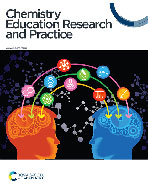Analytical chemistry students’ explanatory statements in the context of their corresponding lecture
Abstract
Conceptually understanding chemistry requires the ability to transition among representational levels to use an understanding of submicroscopic entities and properties to explain macroscopic phenomena. Past literature describes student struggles with these transitions but provides limited information about upper-level post-secondary chemistry students’ abilities to transition among levels. This group is of particular interest as they are engaging in potentially their final training before entering a career as professional chemists, thus if students are likely to develop this skill during their formal education it should be manifest among this group. This study characterized analytical chemistry students’ responses to open-ended assessments on acid–base titrations and thin-layer chromatography for the use of sub-microscopic entities or properties to explain these macroscopic phenomena. Further, to understand whether explanatory statements were an expectation inherent in the instructional context of the setting, the analytical chemistry instructor's lectures on acid–base titrations and thin-layer chromatography were analyzed with the same framework. The analysis found that students seldom invoked explanatory statements within their responses and that congruence between lectures and responses to assessment was primarily limited to the use of macroscopic, descriptive terms. Despite the fact that the lecture in class regularly invoked explanatory statements in one context, this did not translate to student use of explanatory statements. To further test the hypothesis that analytical chemistry students struggle with explanatory statements, a follow-on study was also conducted among a second cohort of students reviewing their responses when specifically prompted to use sub-microscopic entities to explain a macroscopic phenomenon. The results suggest that fewer than half of the students showed proficiency on generating explanatory statements when explicitly prompted to do so. Instructional implications to promote explanatory statements are proposed in the discussion.


 Please wait while we load your content...
Please wait while we load your content...